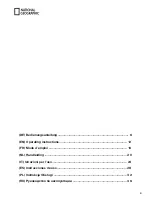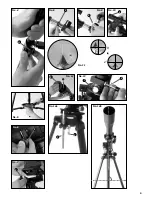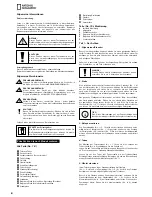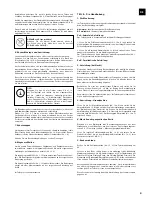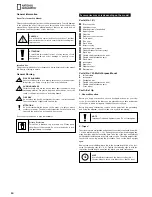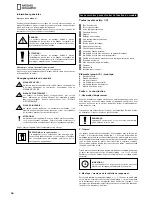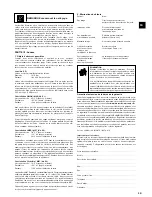
14
and the declination axis in that order, and position the telescope so that the
polar star appears in the center of the eyepiece's field of vision (No. 17).
Then retighten the polar vertical clamping screw and the declination axis.
Once you make this alignment, do not move or adjust the telescope, or it will
become misaligned. The telescope is now correctly aligned. This procedure
is essential so you can track celestial objects.
6. Tracking and Observation Positioning
Tilt the telescope 90° using the declination axis (No. 15, C). Then turn the
telescope 180° to the right or left, until the objective lens points skyward.
Tighten the clamping screws on the two flexible shafts (No. 13, X and Y) so
that you can track stars using these flexible shafts. Manual use of the flexible
shaft along the right ascension axis (No. 15, D) compensates for the Earth's
rotation, so that objects always remain visible in the eyepiece.
If you want to track a different celestial object than the one you're currently
focused on, undo the clamping screws on the flexible shafts (No. 13, X and
Y), reposition the telescope, and then retighten the clamping screws. You
can then use the flexible shafts to do fine adjustments to the telescope's
position.
HINT
The latitude of your observation site can be found in
maps or on the Internet. A good source of information is
www.heavens-above.com
. After checking “anonymous
user” > “select” you may choose your country and city.
i
7. Viewfinder
The telescope is now roughly aligned and adjusted.
In order to obtain a comfortable observation position, you should loosen the
screws on the tube ring (No. 1, 8), so that you can rotate the telescope tube.
Bring the eyepiece and the viewfinder into a position that makes it comfort-
able for you to look through both.
Fine alignment is done using the viewfinder scope. Look through the view-
finder scope and centre Polaris (No. 16) in the middle of the crosshairs (No.
17).
For fine adjustments, use the flexible shafts along the right ascension axis
(No. 15, D) and the declination axis (No. 15, E).
8. Observation
After you have located the pole star in the viewfinder scope, if you look
through the eyepiece, the pole star will be visible.
If necessary, you can use the flexible shafts to align the star more exactly,
just as you can adjust the image sharpness by using the focus wheel (No.
15, F).
Furthermore, you can now, by changing the eyepiece, increase the magnifi-
cation. Note that the magnification of the stars can hardly be seen.
HINT
Eyepieces enlarge the picture of the telescope’s prime
focus. The less the eyepiece’s focal lengths is, the stron-
ger the magnification is. So various eyepieces are needed
to reach different magnifications. Begin every observation
with a low magnification (20 mm eyepiece), and increase
the magnification until you reach the desired picture size.
i
9. Find a Star
Initially it will be difficult for you to find your bearings in the firmament, since
the stars and the constellations are always moving, and according to the
season, date and time, their position in the heavens will change. The pole
star (Polaris) is the exception. It is a fixed star and the starting point for all
star maps.
When you first start observing, you should look at some well-known constel-
lations and star groups that are visible all year round. Remember that the
position of even constantly visible constellations shifts throughout the year.
If you have aligned your telescope accurately to observe one of these stars,
you will find that it vanishes from your field of view after a few minutes. To
even out this effect, you must turn the flexible handle (No. 15, D) along the
declination axis and your telescope will follow the trajectory of this star.
10. Accessories
Your telescope comes with three eyepieces (No. 2, 18).
By interchanging the eyepieces, you can alter the magnification of your
telescope.
Formula for calculating magnification:
Focal length (Telescope) ÷ Focal length (Eyepiece) = Magnification
Examples:
Focal length
of telescope
Focal length
of eyepiece
Magnifi cation
Magnifi cation
with 1.5 erecting lens
900 mm
20 mm
45X
67X
900 mm
12 mm
75X
112X
900 mm
4 mm
225X
337X
The diagonal mirror (No. 2, 19) causes the image you view to be horizontally
reversed. You should use the diagonal mirror whenever making terrestrial
observations.
In order to see an upright and sidecorrect picture, you may use the erect-
ing lens. Loosen the screw (No. 8, X) and remove the diagonal mirror from
the eyepiece connection tube (No. 1, 6). Now put the erecting lens (No. 2,
20) in place and retighten the screw. Finally, put an eyepiece in place and
tighten the screw (No. 9, X).
11. Dismantling
After your interesting and successful observation, it is recommended that
you store the entire telescope in a dry, well-ventilated area. On some tel-
escopes, the tripod and mount can easily be separated. The adjustments to
the mount will remain intact.
Don't forget to put the dust protection caps onto the barrel opening and the
eyepiece connection. Also, you should stow all the eyepieces and optical
accessories into their corresponding receptacles.
HINT
The erecting lens is not recommended for astronomical
observations. Only use the diagonal mirror here.
To observe landscapes, you may use the erecting lens.
i
Notes on Cleaning
Clean the eyepieces and lenses only with a soft, lint-free cloth, like a micro-
fibre cloth. To avoid scratching the lenses, use only gentle pressure with the
cleaning cloth.
To remove more stubborn dirt, moisten the cleaning cloth with an eyeglass-
cleaning solution, and wipe the lenses gently.
Protect the device from dust and moisture. After use, particularly in high
humidity, let the device acclimatize for a short period of time, so that the
residual moisture can dissipate before storing. Remove the dust protection
cap and store it in the included bag during use.



